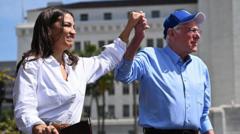The Democratic Party faces a critical moment as activists and leaders articulate various strategies to confront disunity following their election losses. Rallies led by figures like Alexandria Ocasio-Cortez and Bernie Sanders highlight grassroots dissatisfaction, while debates over moderating tactics versus progressive stances continue among party members.
Navigating Turbulent Waters: Democrats Seek Unity Amid Discontent

Navigating Turbulent Waters: Democrats Seek Unity Amid Discontent
As the Democratic Party grapples with internal divisions and discontent among supporters, leaders explore diverse strategies for unification and opposition to Trump.
Amidst a backdrop of political turmoil, the Democratic Party is seeking a cohesive path forward, as internal divisions and dissatisfaction among its base threaten collective efficacy. Recent events, including a rally in Bakersfield, California hosted by Congresswoman Alexandria Ocasio-Cortez and Independent Senator Bernie Sanders, reflect a grassroots urge for stronger opposition to President Donald Trump's influence. Their "Fighting Oligarchy" tour aims to bolster Democratic resolve, particularly in conservative regions that the party historically struggles to connect with.
At the rally, local Democrats expressed frustration with the party's perceived failings in opposing Trump's agenda. The mood was animated, with attendees passionately voicing their belief that Democratic leaders can and should do more. Karla Alcantar, a rally-goer, remarked, “I feel like some of them have just folded over completely,” underscoring sentiments prevalent within the party’s supporters. This impotent feeling is corroborated by a recent CNN/SSRS poll that indicates 52% of Democratic voters feel party leadership is heading in the wrong direction, with a majority adamant about needing stronger opposition to Republican policies.
The Democratic coalition is currently fractured both ideologically and generationally—some factions promoting moderation, while others advocate for a more aggressive progressive stance. Notable figures, including former Pennsylvania congressman Conor Lamb, highlight a yearning among constituents for a greater sense of urgency in the current political climate. Amid the existential frustrations of the party's base, Lamb noted, "They want us to act with that level of urgency."
As they traverse traditionally Republican terrain, Sanders and Ocasio-Cortez's narrative seeks to connect economic woes with the faults of oligarchy, framing Trump and billionaires as deleterious to the average American's livelihood. Yet the "Fighting Oligarchy" campaign is only one narrative amidst broader discussions on the future of the party. California Governor Gavin Newsom has recently advocated for centrist branding and engaging with opposing perspectives, although his approaches have sparked fierce debate within the party.
Newer leaders like gun control advocate David Hogg are calling for primary challenges against entrenched Democrats who do not resonate with newer voters, pushing back against veteran strategists who caution against internal conflicts. As tensions simmer, party members and leaders are under pressure to transform rhetoric into tangible action that resonates with disillusioned constituents.
For many activists, the decisive factor remains simple: they need their leaders to act, and do so with vigor. Local constituents continue to seek demonstrations of commitment, as evidenced by support for Senator Cory Booker’s lengthy filibuster against Trump policies. In this charged atmosphere of internal conflict yet strong activism, the Democratic Party finds itself at a crossroads, facing the challenge of reconciling its diverse voices while striving for a united front.




















